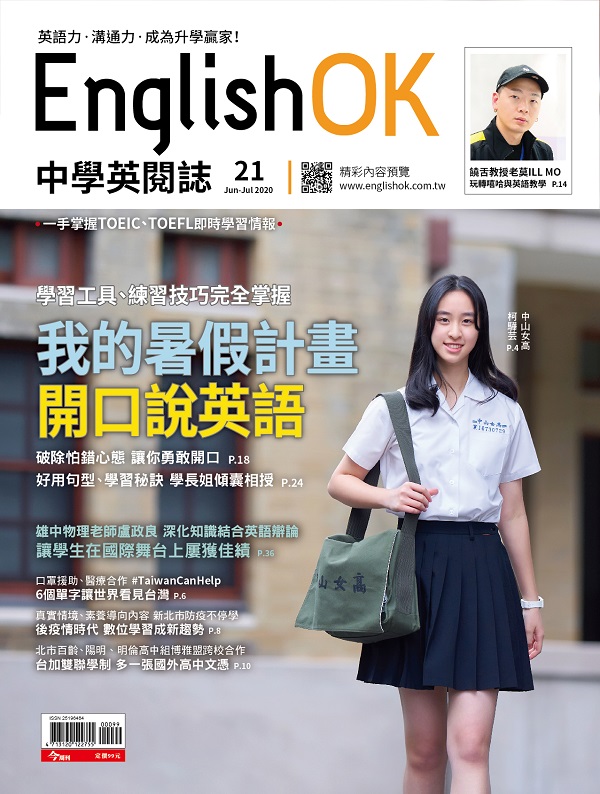
前二期專欄我們談了引用資料的基本觀念及直接引述的格式,直接引述主要分二類:插入引用語(run-in quotations) 與獨立的引語段(block quotations),其中插入引用語較為常用,可強化引用內容的專業可信度,又能豐富整個段落的文法句型。
插入引用語的三大常見模式
1. 插入完整句子:例1中,作者首先摘述原著的一大論點,即正向的互動對人類及靈長類動物有所助益(見第1句),接著使用「引號」直接引用一個完整句,以支持或呼應論點(見第2句),要留意的是,若需在句尾標示出處(in-text citation),引文句號應標示於出處之後。範例中第3句則是作者以個人論點強化第1句的概念。
【例1】1 In his book, Conniff (2018) makes the case that interacting in a kind and polite way is more beneficial for both humans and primates. [⋯] 2 “We function as part of a group rather than as individuals” (Conniff, 2018, p. 7). 3 Employees who cooperate in the office and primates who cooperate in the wild find themselves happier, more effective, and more likely to survive.
來源/Vargo, M. & Blass, L. (2018). Pathways 3: Reading, Writing, and Critical Thinking (2nd ed.). Boston, MA: Cengage Learning.
2. 插入子句:如例2所示,作者提及飲食習慣所引發的肥胖問題(見第1 、2 句),之後引用了二個獨立子句(見第3 、4句粗體)說明這個問題還需要更深入的思考。作者無需使用冗長的獨立引語段,只需在二大子句間,插入原作者的單位與職稱加以說明,藉此強化引用內容的專業可信度,又能豐富整個段落的文法句型。
【例2】1 France’s growing fat problem underscores how inexorable the Americanization of food habits has become. 2 The problem is even more acute in the developing world, where the taste for American fast-food products like McDonald’s hamburgers and Coca-Cola has long been fashionable. [⋯] 3 “It’s very easy to blame globalization, or the big brands like Coca-Cola or McDonald’s,” says Derek Yach, executive director of the World Health Organization’s disease prevention, nutrition, diet and physical-fitness program. 4 “But the problem goes much, much deeper.”
來源/ The deadly noodle (2003, January). Newsweek.Retrieved March 14, 2020
3. 插入片語:透過引述原文的名詞、動詞或介系詞片語等,可避免大量直接引述太多原文的完整句子。
例3中,作者採用主詞+動詞+補語,引用了一個名詞片語作為主詞補語,並在後方使用“This closeness”開頭,以補充說明所引用的名詞片語。
【例3】According to Glaeser (2018), cities are “the absence of space between people” (p. 54). This closeness reduces the cost of transporting goods, people, and ideas, and allows people to be more productive.
來源/Vargo, M. & Blass, L. (2018). Pathways 3: Reading, Writing, and Critical Thinking (2nd ed.). Boston, MA: Cengage Learning.
而例4則是引用動詞片語, 作者引述了以“allows…”為首的動詞片語,將其融入了一個以that導出的關係子句(relative clause)之中。
【例4】Decades of experience and failures have yielded a conversation strategy that, according to Rabinowitz (as cited from Blass & Vargo, 2018), “allows any site or landscape to increase its tigers if followed correctly.” Central to this approach is the need for …
來源/ Blass, L & Vargo, M. (2018). Pathways 4: Reading, Writing, and Critical Thinking (2nd ed.). Boston, MA: Cengage Learning.
直接引述常用報導動詞
直接引述過程中,亦需使用報導動詞來導入引述內容,常見的報導動詞大致可分為三類:
1. 表達中立:僅提供事實或資訊,如say、write、 add、state、remark、explain或note等。
2. 表達對原著質疑的立場:若作者對原著不認同或有所懷疑,常使用argue、claim、suggest等動詞,並在之後表達質疑論點。如例5,作者先引用Yang的立場(見第1 句),使用argue顯示不認同的態度,其後第2句講述了有效的課堂筆記有賴技巧訓練,無法單單因為“asking”(教師要求)而能施作。
【例5】1 As Yang (2010) argues, “English teachers should ask students to take notes during their class meetings for future review” (p.10). 2 However, some experts believe that “asking” itself might not be helpful. If note-taking skills are not explicitly taught, students’ notes might not really help them review after classes.
3. 表達對原著研究發現的認同或觀點一致:如prove、show 或demonstrate。
本期我們探討了插入引用語的常見模式,根據不同需求可選擇插入完整句子、子句或片語,考驗能否充分掌握引述內容的文法和句型變化。
多數情況下,需在直接引用時建立自我和原著立場的連結,有利於選擇適宜的報導動詞進行合宜的引用,下期我們將繼續介紹報導動詞的用法。
文/林麗菊
現職:國立中正大學語言中心副教授
學歷:美國加州大學聖塔芭芭拉分校教育博士
專長:社會語言學、教育研究法、學術英文教學、字彙與閱讀教學
文/李佳家
現職:國立中正大學語言中心助理教授
學歷:國立台灣師範大學英語教學博士
專長:商務英文溝通、學術英文


